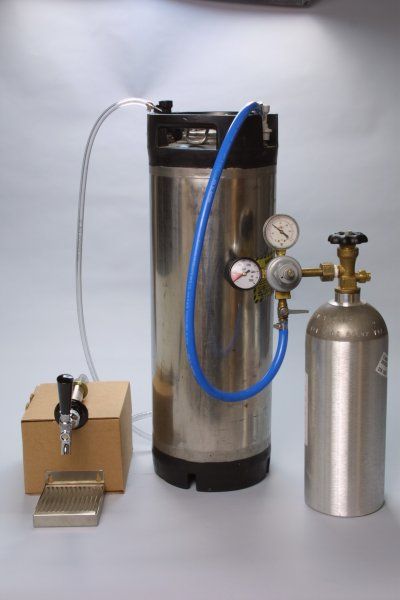Pale Ale #2
6.6 pounds of Light Malt Extract.
1/2 pound crystal malt, 50 degrees Lovibond.
2 oz chocolate malt.
1 oz Cascade hops, 60 minutes.
1 oz Cascade hops, 30 minutes.
1 oz Amarillo hops, 30 minutes.
1 tsp Irish moss, 15 minutes.
1 oz Amarillo hops, 5 minutes.
Overpitched American Ale (Wyeast 1056) from the dregs of pale ale #1.
Mary at HSHB pointed out the grapefruit aroma of the cascades versus the tangerine bouquet from the Amarillo. We brewed Sunday night, and there was practically no lag time. By the morning, the yeast was already showing steady but relatively slow activity. By this morning, the fermenter's heavy plastic lid was distended and bloated with gas. The airlock is pointing at a 60 degree angle, but still holding as the only path of release for carbon dioxide and foam. I'm periodically wiping the sticky bubbles from the airlock cap to prevent blowout. I think from now on, I'm going to use sanitized surgical tube for a blow hose.
Tom from Yards gave me the tip to overpitch the yeast and finish primary fermentation as fast as possible. Good advice I think: at this rate, the beer will be ready for the secondary fermenter within 4 days total.
Brown Ale #1 is now drinkable. We only used 3.3 pounds of malt extract in that batch, and while it's tasty, it's definitely on the weak side. Brown ale #2 is just getting to the drinkable stage, still a bit green, but packs a bit more of a wallop. Crisper too.
I've decided within the next 2 months to switch to a keg system. I've been brewing every week, because I was under the impression that yeast from dregs wouldn't last more than a day or two. Actually, the yeast can sit in the fridge for a week. I was reluctant to do kegs because it takes a lot more time to consume 5 gallons of beer than it does to create it. I'd be buying a keg every week! On the other hand, if I purchase, over time, something like 5 kegs (Cornelius kegs, not beer kegs), I would have enough on hand to brew every other week and always have a keg on hand.

Problem is, and investment in that many used kegs (new kegs are out of the question costwise) is likely to be $150-$300. OUCH. Then there's the initial cost of the CO2 tank, the pressure regulator, and a second refrigerator.
Another idea would be to brew every other month, using 3 or 4 kegs. Brew a series of pale ales in January; drink pales in February, maybe set aside a keg for a party later in the year. Spend March brewing browns; spend May brewing wheats; and so on.
I now have to eat some lunch and get ready to go to Home Depot to schedule an estimate for my upstairs carpetting. It's that time of year!
1/2 pound crystal malt, 50 degrees Lovibond.
2 oz chocolate malt.
1 oz Cascade hops, 60 minutes.
1 oz Cascade hops, 30 minutes.
1 oz Amarillo hops, 30 minutes.
1 tsp Irish moss, 15 minutes.
1 oz Amarillo hops, 5 minutes.
Overpitched American Ale (Wyeast 1056) from the dregs of pale ale #1.
Mary at HSHB pointed out the grapefruit aroma of the cascades versus the tangerine bouquet from the Amarillo. We brewed Sunday night, and there was practically no lag time. By the morning, the yeast was already showing steady but relatively slow activity. By this morning, the fermenter's heavy plastic lid was distended and bloated with gas. The airlock is pointing at a 60 degree angle, but still holding as the only path of release for carbon dioxide and foam. I'm periodically wiping the sticky bubbles from the airlock cap to prevent blowout. I think from now on, I'm going to use sanitized surgical tube for a blow hose.
Tom from Yards gave me the tip to overpitch the yeast and finish primary fermentation as fast as possible. Good advice I think: at this rate, the beer will be ready for the secondary fermenter within 4 days total.
Brown Ale #1 is now drinkable. We only used 3.3 pounds of malt extract in that batch, and while it's tasty, it's definitely on the weak side. Brown ale #2 is just getting to the drinkable stage, still a bit green, but packs a bit more of a wallop. Crisper too.
I've decided within the next 2 months to switch to a keg system. I've been brewing every week, because I was under the impression that yeast from dregs wouldn't last more than a day or two. Actually, the yeast can sit in the fridge for a week. I was reluctant to do kegs because it takes a lot more time to consume 5 gallons of beer than it does to create it. I'd be buying a keg every week! On the other hand, if I purchase, over time, something like 5 kegs (Cornelius kegs, not beer kegs), I would have enough on hand to brew every other week and always have a keg on hand.

Problem is, and investment in that many used kegs (new kegs are out of the question costwise) is likely to be $150-$300. OUCH. Then there's the initial cost of the CO2 tank, the pressure regulator, and a second refrigerator.
Another idea would be to brew every other month, using 3 or 4 kegs. Brew a series of pale ales in January; drink pales in February, maybe set aside a keg for a party later in the year. Spend March brewing browns; spend May brewing wheats; and so on.
I now have to eat some lunch and get ready to go to Home Depot to schedule an estimate for my upstairs carpetting. It's that time of year!
0 Comments:
Post a Comment
<< Home